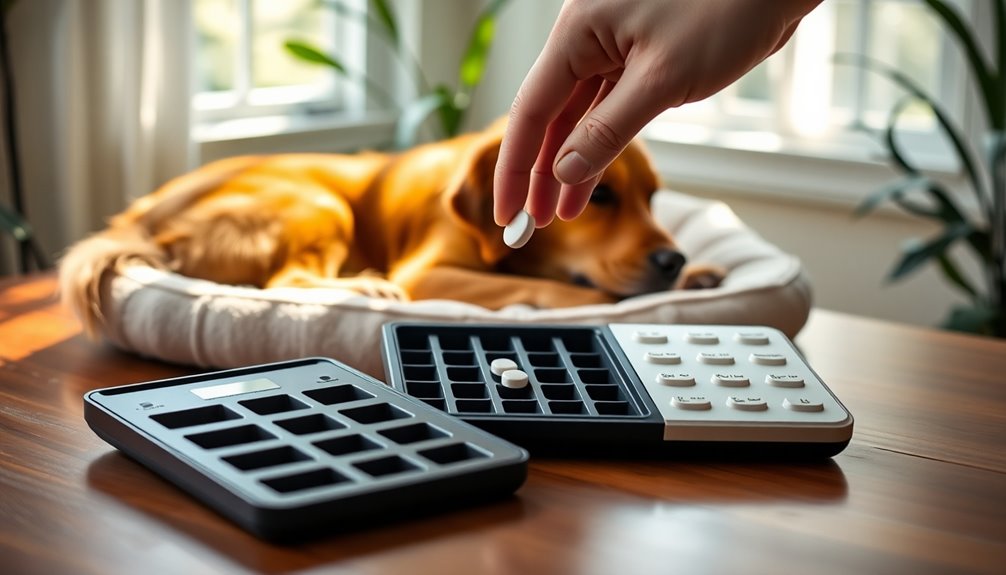You can give your dog trazodone safely, but the right dosage is essential. The typical starting dose is 1 to 5 mg per kg of your dog's weight, or about 1-3 mg per pound. For example, dogs under 22 lbs generally receive 25 mg, those between 22-44 lbs get 50 mg, and dogs over 44 lbs may need 100 mg. Always consult your veterinarian first to tailor the dosage to your dog's specific needs and monitor any side effects. Understanding how to administer trazodone effectively can enhance your dog's comfort and safety, so stick around for more valuable tips.
Key Takeaways
- Trazodone dosages typically range from 1 to 5 mg per kg of body weight, depending on the dog's specific needs.
- Initial dosages are approximately 25 mg for dogs under 22 lbs, 50 mg for 22-44 lbs, and 100 mg for over 44 lbs.
- Administering Trazodone with food can enhance absorption and reduce gastrointestinal upset.
- Consult a veterinarian for tailored dosage recommendations and monitor for side effects or required adjustments.
- Regular follow-ups with the vet are essential for assessing effectiveness and maintaining safe treatment.
What Is Trazodone?
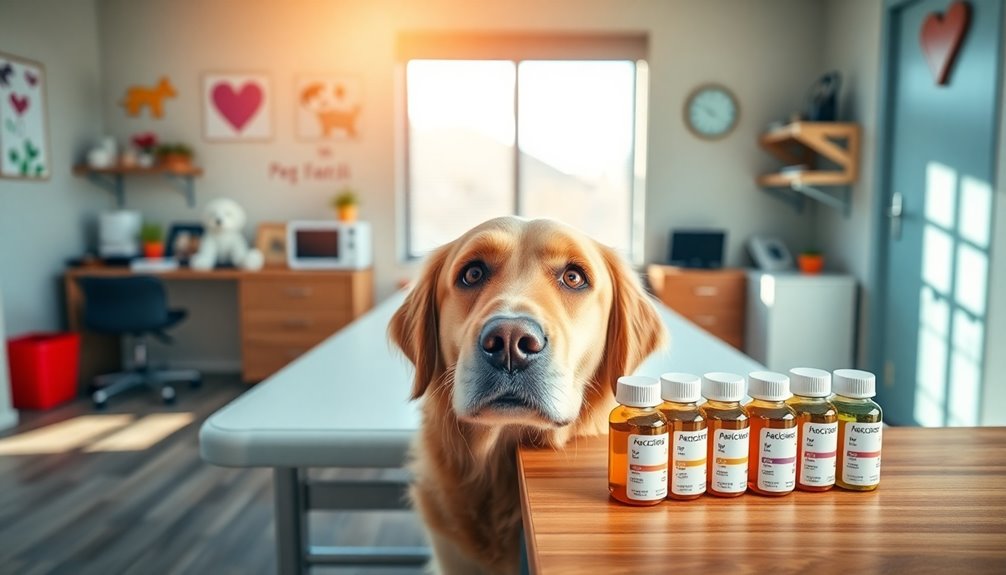
Trazodone is an antidepressant medication commonly prescribed to help dogs manage anxiety and behavioral issues, such as separation anxiety and noise phobias.
As a serotonin antagonist and reuptake inhibitor, it increases serotonin levels in your dog's brain, promoting relaxation and mood stabilization.
Although it's not FDA-approved for veterinary use, veterinarians widely use trazodone due to its effectiveness.
The medication comes in various tablet dosages, typically ranging from 50 mg to 300 mg, and your veterinarian will determine the appropriate dosage of trazodone based on your dog's weight and health needs.
Be aware of potential side effects, including sedation, increased hunger, and gastrointestinal upset, so you'll need to monitor your dog closely during treatment for any adverse reactions.
Uses of Trazodone in Dogs
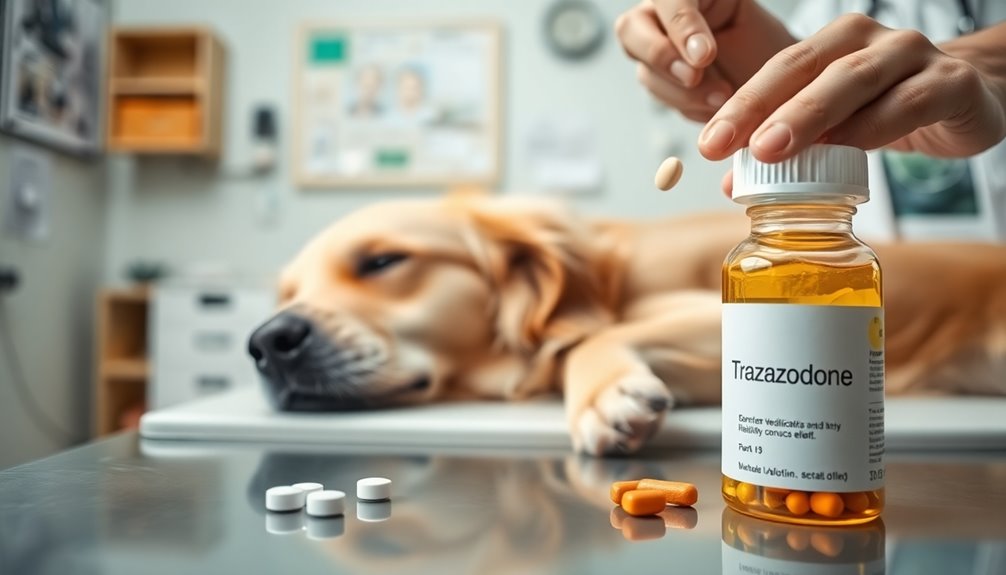
When your dog faces anxiety or stress, trazodone can be a valuable tool to help manage their behavior. This medication is often used as part of a thorough treatment plan for various issues.
Here are some common uses of trazodone in dogs:
- Reducing anxiety related to separation or loud noises
- Controlling excessive barking and howling
- Addressing compulsive behaviors
- Promoting calmness during recovery from surgery
It's essential to consult your veterinarian for the correct dosage and to verify it's a safe and effective option for your dog.
Trazodone isn't FDA-approved for veterinary use, but its widespread recognition in practices speaks volumes about its ability to improve canine well-being and manage behavior problems.
How Trazodone Works

Trazodone works by blocking the reuptake of serotonin, which helps boost serotonin levels in your dog's brain.
This increase not only promotes relaxation but also provides anxiolytic and hypnotic effects, making it easier for your pup to cope with anxiety.
Understanding the proper dosage and administration guidelines is essential for achieving the best results.
Serotonin Reuptake Inhibition
Understanding how trazodone works is essential for effectively managing your dog's anxiety. Trazodone functions as a serotonin antagonist and reuptake inhibitor, helping alleviate anxiety by inhibiting the reuptake of serotonin.
This mechanism stabilizes mood and reduces anxiety symptoms, making it an effective choice for dogs facing stressful situations.
- Enhances serotonin availability
- Provides anxiolytic effects
- Offers sedation and anxiety relief
- Allows for appropriate dosage adjustments
Anxiolytic and Hypnotic Effects
How do anxiolytic and hypnotic effects work in dogs? Trazodone acts as a serotonin antagonist and reuptake inhibitor, increasing serotonin levels to reduce anxiety and promote calmness.
This tranquilizer helps dogs cope with stressful situations, like separation or noise phobias, by alleviating their anxiety symptoms. Its anxiolytic effects are essential during anxiety-inducing events.
Additionally, Trazodone's hypnotic properties aid in promoting sleep, benefiting dogs facing insomnia related to anxiety.
While higher dosages can lead to sedation and even antidepressant effects, it's important to follow careful dosing guidelines recommended by your veterinary professional.
The right dosage guarantees that you maximize the beneficial effects while minimizing the risk of excessive sedation in your dog.
Dosage and Administration Guidelines
When it comes to administering Trazodone to your dog, following precise dosage and administration guidelines is vital for achieving the desired calming effects. The Trazodone dosage typically ranges from 1 to 5 mg per kg of body weight, administered every 8 to 24 hours.
Here are some key points to take into account:
- Start with an initial dosage based on weight-based guidelines.
- Administer Trazodone about 90 minutes before stressful situations.
- Giving it with food can reduce gastrointestinal upset.
- Schedule regular veterinary consultations for dosage adjustment and monitoring.
Keep in mind that potential side effects can occur, so it's important to stay vigilant in your dog's anxiety management.
Safe Dosage Guidelines

Determining the right dosage of trazodone for your dog is essential for their safety and well-being. Trazodone dosage should be based on your dog's weight and specific behavior issues. Always consult your veterinarian to establish the appropriate dosage, considering any medical conditions. Start with an initial dose and monitor for side effects, making adjustments based on response.
| Dog Weight | Initial Dose | Target Dose |
|---|---|---|
| Less than 22 lbs | 25 mg | 50 mg |
| 22-44 lbs | 50 mg | 100 mg |
| Over 44 lbs | 100 mg | 200 mg |
Gradual increases may be necessary, so keep a close eye on your dog's reaction during treatment.
Risks of Overdosing
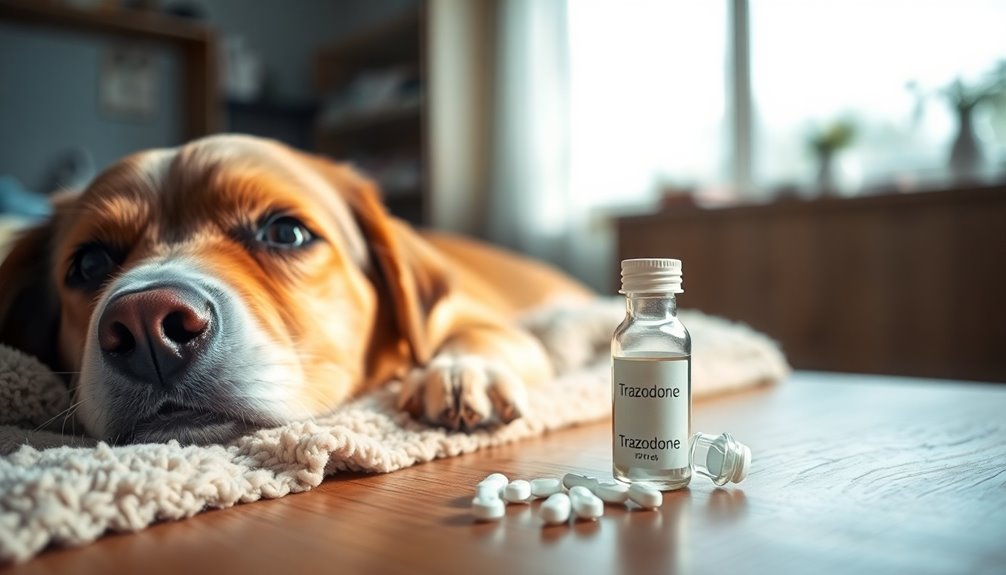
When it comes to trazodone, knowing the symptoms of overdose is essential for your dog's safety.
If you notice any signs like lethargy or incoordination, you need to act quickly and contact your veterinarian.
Understanding how to prevent an overdose can help keep your furry friend healthy and happy.
Symptoms of Overdose
Overdosing on trazodone can lead to serious health risks for your dog, so it's vital to recognize the symptoms early.
Watch for signs of overdose, as they can escalate quickly and require immediate veterinary care. Common symptoms include:
- Excessive sedation and lethargy
- Respiratory distress and impaired balance
- Increased heart rate and hypotension
- Seizures and signs of serotonin syndrome
If you notice any of these symptoms, it's important to act fast.
The risk of serious complications, including permanent damage or death, increases the longer you wait. Always prioritize your dog's health and consult your veterinarian if you suspect an overdose.
Emergency Response Steps
If you suspect your dog has overdosed on trazodone, acting quickly is essential to guarantee their safety. Look for signs like excessive sedation, lethargy, and decreased responsiveness.
These symptoms require immediate veterinary attention. Don't wait—contact a veterinarian or an emergency animal hospital without delay for appropriate treatment.
Your vet may administer supportive care, such as IV fluids, and closely monitor for complications like serotonin syndrome, which can cause agitation and seizures.
Be aware that incoordination increases the risk of injury in an overdose situation. Remember, timely intervention can greatly improve your dog's chances of recovery, so don't hesitate to seek help if you notice any adverse effects.
Your quick response could make all the difference.
Prevention Strategies
Preventing an overdose of trazodone in your dog starts with understanding the proper dosage and monitoring their response to the medication.
Here are some strategies to help you prevent overdosing:
- Follow the recommended dosage based on your dog's weight and health condition.
- Monitor for any adverse effects, such as lethargy or incoordination, after administering trazodone.
- Use gradual titration to adjust the dosage, especially for smaller dogs with severe anxiety.
- Schedule regular vet visits to guarantee your dog's serotonin levels and overall health are stable.
Side Effects to Monitor
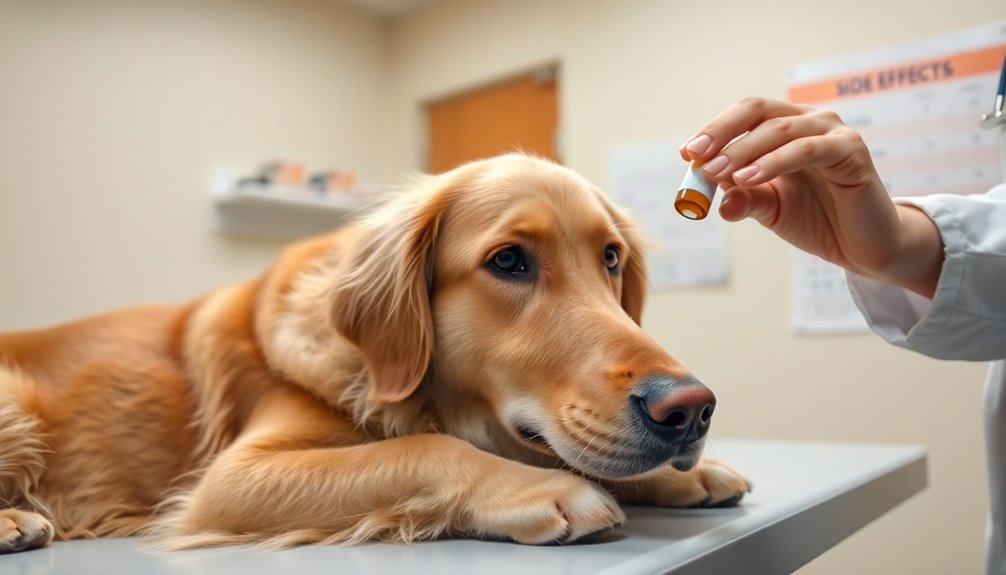
While trazodone can be effective for managing anxiety in dogs, it's essential to monitor for potential side effects throughout the treatment.
Common side effects of trazodone include sedation, diarrhea, increased hunger, and vomiting, so you should monitor closely during this time. Some dogs might experience hyperactivity or impulsive behaviors, indicating a need for dosage adjustments.
Although rare, serious adverse effects can occur, such as signs of liver damage, hypotension, and serotonin syndrome, which require immediate veterinary attention.
Keep a close eye on your dog, especially during the initial treatment phase, as many side effects may decrease as their body adjusts.
If you notice any side effects, consult your veterinarian for guidance on managing symptoms or adjusting the treatment plan.
Administering Trazodone Safely
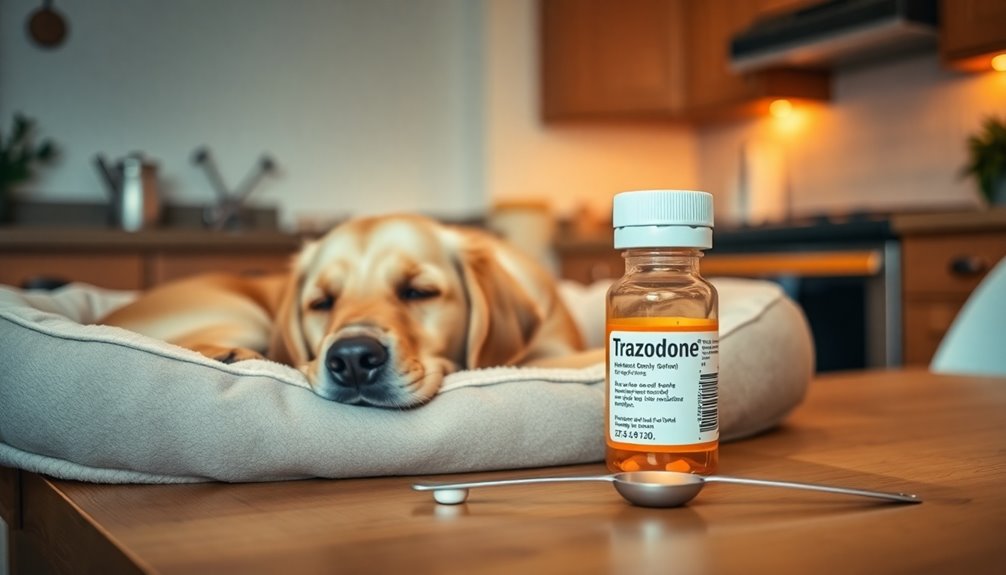
Monitoring for side effects is just the beginning of guaranteeing your dog's well-being on trazodone.
To administer trazodone safely, you need to follow specific guidelines based on your dog's weight. Here are some key points:
- Start with a dose of 1-3 mg per pound of your dog's weight.
- Common initial dosages: 25 mg for dogs under 22 lbs, 50 mg for 22-44 lbs, and 100 mg for those over 44 lbs.
- Always give trazodone with food to enhance absorption and reduce gastrointestinal upset.
- Adjust dosages gradually, based on your dog's tolerance and response.
Always consult your veterinarian for precise guidance and never exceed the recommended dose to guarantee the safety and health of your dog.
Consulting Your Veterinarian
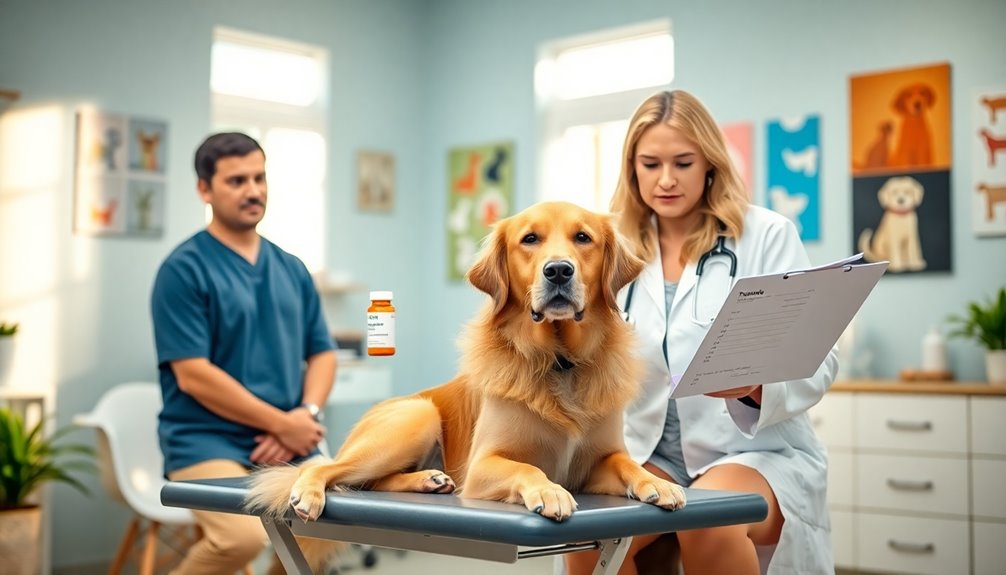
Consulting your veterinarian is fundamental for determining the right trazodone dosage for your dog, as they can tailor a plan based on your pet's weight, age, and health conditions.
Your vet will start with a lower dose, gradually increasing it based on your dog's response and tolerance. Regular follow-ups are essential to assess the drug's effectiveness and make any necessary adjustments.
They'll also evaluate potential drug interactions with your dog's current medications. Open communication about any side effects or behavioral changes you observe is critical for safe and effective trazodone administration.
Frequently Asked Questions
Can I Use Trazodone for My Puppy?
You can use trazodone for your puppy, but it's essential to consult your vet first.
They'll assess your pup's specific needs and health conditions, ensuring it's safe for them. Trazodone is often prescribed to help with anxiety or to calm dogs during stressful situations.
Just remember, don't administer any medication without professional guidance, as dosages and potential side effects can vary considerably between puppies and adult dogs.
Always prioritize your puppy's safety!
How Long Does Trazodone Take to Work?
Trazodone usually starts working within one to two hours after you give it to your dog.
You'll notice a calming effect as the medication kicks in, helping to ease anxiety or stress.
Keep an eye on your pup during this time to see how they respond.
If you don't see the desired effects within a few hours, it's best to consult your vet for further guidance on dosage or alternatives.
What Should I Do if I Miss a Dose?
If you miss a dose, don't panic. Just give your dog the missed dose as soon as you remember, unless it's almost time for the next one.
In that case, skip the missed dose and return to the regular schedule.
Never double up on doses, as that can increase the risk of side effects.
Always consult your vet if you have any concerns or if your dog shows unusual behavior after missing a dose.
Can Trazodone Be Given With Other Medications?
Did you know that nearly 70% of dogs in therapy settings are prescribed medications like trazodone?
It's essential to consult your vet before mixing trazodone with other medications. Some combinations can lead to harmful interactions.
Your vet will assess your dog's health, current meds, and any potential risks. Always follow their guidance to guarantee your furry friend stays safe and comfortable while receiving the best care possible.
Don't hesitate to ask questions!
Are There Any Natural Alternatives to Trazodone?
If you're looking for natural alternatives to trazodone for your dog, consider options like chamomile, valerian root, or melatonin.
These can help promote relaxation and reduce anxiety. Always consult your vet before trying any new treatment, as they can guide you on what's safe and effective for your furry friend.
Additionally, regular exercise and a consistent routine can also support your dog's overall well-being and help alleviate stress naturally.
Conclusion
To summarize, when it comes to your furry friend's well-being, it's crucial to tread carefully with trazodone. By sticking to the safe dosage guidelines and keeping an open line of communication with your vet, you can help guarantee a peaceful, stress-free experience for your pup. Remember, a little caution goes a long way in safeguarding their health, allowing them to glide through their day with calm and comfort. Your attentive care is their best ally!

